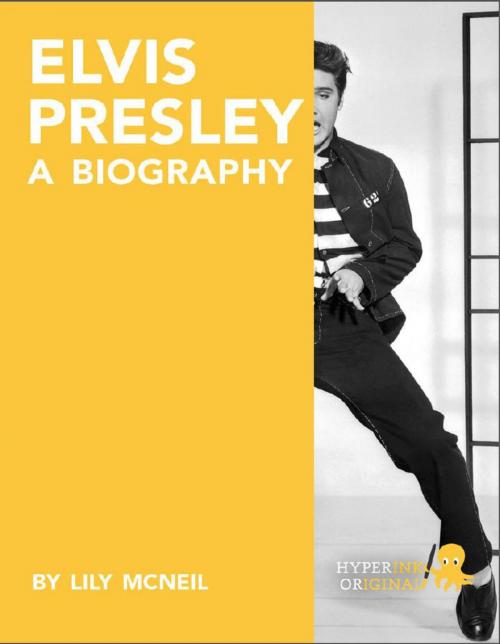| Author: | Lily McNeil | ISBN: | 9781614645269 |
| Publisher: | Hyperink | Publication: | July 30, 2012 |
| Imprint: | Hyperink | Language: | English |
| Author: | Lily McNeil |
| ISBN: | 9781614645269 |
| Publisher: | Hyperink |
| Publication: | July 30, 2012 |
| Imprint: | Hyperink |
| Language: | English |
ABOUT THE BOOK
“If he did things like that in the street, we’d lock him up.”
—Oakland, CA Officer 230, assigned to security at Elvis Presley’s June 3, 1956 show at the Oakland Auditorium, in reference to Elvis' dance style
You may know him by his epithets: The King of Rock ‘n’ Roll, or maybe just The King. Memphis Flash. The Hillbilly Cat. Elvis the Pelvis. Sir Swivel, perhaps.
Elvis Presley was a teen girl’s heartthrob, a studio’s golden goose, a movie star, a sexual icon, a rock legend. He battled both internal demons and management fiascos. He loved music, and both loved and loathed the fame it brought him.
He influenced singers and bands as diverse as The Beatles, The Rolling Stones, Led Zeppelin, Bob Dylan, Buddy Holly, Tom Jones, Bruce Springsteen, Neil Diamond, Pat Benatar, Queen, The Clash, Billy Idol, and Elton John. He found his sound in African-American gospel music and blended it with country and blues to produce a newfangled thing called “rock ‘n’ roll.”
He started out with nothing and ended his life as a wealthy and generous man. He never performed a concert outside of North America (he played five shows in Canada in 1957), and yet his records went gold and platinum in countries such as Belgium, Sweden, Germany, France, Yugoslavia, South Africa, Japan, England, Australia, and Norway. He is known throughout the world by his first name.
He has spurred fan clubs, blogs, impersonators, and tribute acts galore. Sometimes he’s spotted leaving the building, decades after his death.
Graceland, his beloved Memphis mansion, is a mecca for fans worldwide. His records and outlandish costumes are on display, as well as his more personal mementos from an incredible life.
Although his image has often descended into camp, Elvis was first and foremost an artist who was deeply engaged with the history and future of music and with blurring the racial divides in mid-century America. His 1950s material showcases the “musical idiot savant” with the “golden voice” and sensitive readings of popular ballads, while his 1960s and 1970s songs often belie Elvis' confident, stylized exterior.
EXCERPT FROM THE BOOK
The King of Rock ‘n’ Roll came from humble beginnings. Elvis Aaron (later Aron) and his twin brother, Jesse Garon, were born in Tupelo, Mississippi on January 8th, 1935, to Gladys Love and Vernon Elvis Presley. Jesse was stillborn, and as the Presleys did not have any other children, Elvis grew up as an only child. Gladys was 22 years old and Vernon only 18 when they had the future King.
During morning prayers one day at East Tupelo Consolidated, ten-year-old Elvis sang the song “Old Shep” by Red Foley. One of his teachers, dazzled by the performance, encouraged him to enter a singing contest at the 1945 Mississippi-Alabama Fair and Dairy Show. Elvis placed fifth.
After graduating high school in 1953, Elvis decided to cut his first record. He paid Sun Records to make a two-song disc, ostensibly as a present for his mother. While this motivation is indeed likely, Elvis seems to have had other, grander ideas: he wanted to be discovered. The receptionist at Sun Records, Marion Keisker, noted his talents, writing, “Good ballad singer. Hold” under his name.
Sam Phillips, the boss over at Sun Records, invited Elvis back to the studio to record as many songs as he knew. None of them were quite right, and the day looked to be a failure. After they had all called it quits, Elvis began horsing around with his guitar, belting out Arthur Crudup’s 1946 “That’s All Right.” The rest of the band joined in. This was exactly the “white man [with] the Negro sound and the Negro feel” that Phillips was looking for. When the song hit the radio three days later, listeners called in to ask who the singer was...
...buy the book to read more!
ABOUT THE BOOK
“If he did things like that in the street, we’d lock him up.”
—Oakland, CA Officer 230, assigned to security at Elvis Presley’s June 3, 1956 show at the Oakland Auditorium, in reference to Elvis' dance style
You may know him by his epithets: The King of Rock ‘n’ Roll, or maybe just The King. Memphis Flash. The Hillbilly Cat. Elvis the Pelvis. Sir Swivel, perhaps.
Elvis Presley was a teen girl’s heartthrob, a studio’s golden goose, a movie star, a sexual icon, a rock legend. He battled both internal demons and management fiascos. He loved music, and both loved and loathed the fame it brought him.
He influenced singers and bands as diverse as The Beatles, The Rolling Stones, Led Zeppelin, Bob Dylan, Buddy Holly, Tom Jones, Bruce Springsteen, Neil Diamond, Pat Benatar, Queen, The Clash, Billy Idol, and Elton John. He found his sound in African-American gospel music and blended it with country and blues to produce a newfangled thing called “rock ‘n’ roll.”
He started out with nothing and ended his life as a wealthy and generous man. He never performed a concert outside of North America (he played five shows in Canada in 1957), and yet his records went gold and platinum in countries such as Belgium, Sweden, Germany, France, Yugoslavia, South Africa, Japan, England, Australia, and Norway. He is known throughout the world by his first name.
He has spurred fan clubs, blogs, impersonators, and tribute acts galore. Sometimes he’s spotted leaving the building, decades after his death.
Graceland, his beloved Memphis mansion, is a mecca for fans worldwide. His records and outlandish costumes are on display, as well as his more personal mementos from an incredible life.
Although his image has often descended into camp, Elvis was first and foremost an artist who was deeply engaged with the history and future of music and with blurring the racial divides in mid-century America. His 1950s material showcases the “musical idiot savant” with the “golden voice” and sensitive readings of popular ballads, while his 1960s and 1970s songs often belie Elvis' confident, stylized exterior.
EXCERPT FROM THE BOOK
The King of Rock ‘n’ Roll came from humble beginnings. Elvis Aaron (later Aron) and his twin brother, Jesse Garon, were born in Tupelo, Mississippi on January 8th, 1935, to Gladys Love and Vernon Elvis Presley. Jesse was stillborn, and as the Presleys did not have any other children, Elvis grew up as an only child. Gladys was 22 years old and Vernon only 18 when they had the future King.
During morning prayers one day at East Tupelo Consolidated, ten-year-old Elvis sang the song “Old Shep” by Red Foley. One of his teachers, dazzled by the performance, encouraged him to enter a singing contest at the 1945 Mississippi-Alabama Fair and Dairy Show. Elvis placed fifth.
After graduating high school in 1953, Elvis decided to cut his first record. He paid Sun Records to make a two-song disc, ostensibly as a present for his mother. While this motivation is indeed likely, Elvis seems to have had other, grander ideas: he wanted to be discovered. The receptionist at Sun Records, Marion Keisker, noted his talents, writing, “Good ballad singer. Hold” under his name.
Sam Phillips, the boss over at Sun Records, invited Elvis back to the studio to record as many songs as he knew. None of them were quite right, and the day looked to be a failure. After they had all called it quits, Elvis began horsing around with his guitar, belting out Arthur Crudup’s 1946 “That’s All Right.” The rest of the band joined in. This was exactly the “white man [with] the Negro sound and the Negro feel” that Phillips was looking for. When the song hit the radio three days later, listeners called in to ask who the singer was...
...buy the book to read more!















